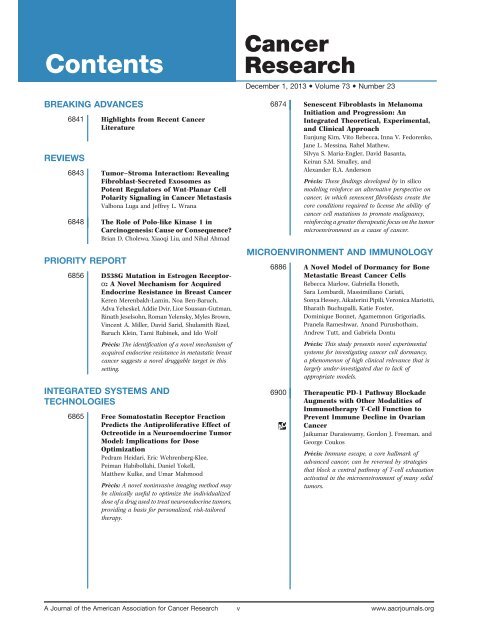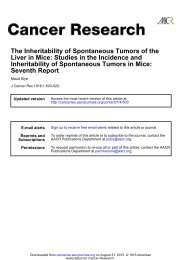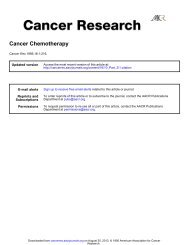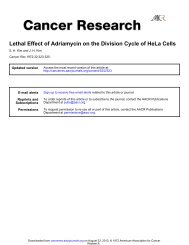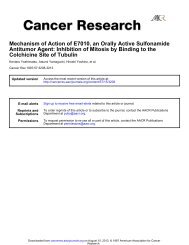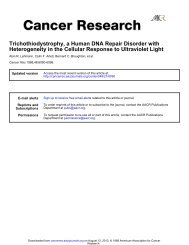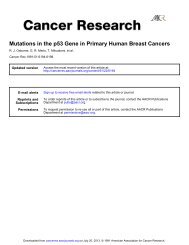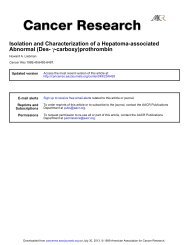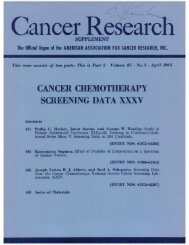Table of Contents (PDF) - Cancer Research - Aacrjournals.org
Table of Contents (PDF) - Cancer Research - Aacrjournals.org
Table of Contents (PDF) - Cancer Research - Aacrjournals.org
You also want an ePaper? Increase the reach of your titles
YUMPU automatically turns print PDFs into web optimized ePapers that Google loves.
<strong>Contents</strong><br />
BREAKING ADVANCES<br />
REVIEWS<br />
6841 Highlights from Recent <strong>Cancer</strong><br />
Literature<br />
6843 Tumor–Stroma Interaction: Revealing<br />
Fibroblast-Secreted Exosomes as<br />
Potent Regulators <strong>of</strong> Wnt-Planar Cell<br />
Polarity Signaling in <strong>Cancer</strong> Metastasis<br />
Valbona Luga and Jeffrey L. Wrana<br />
6848 The Role <strong>of</strong> Polo-like Kinase 1 in<br />
Carcinogenesis: Cause or Consequence?<br />
Brian D. Cholewa, Xiaoqi Liu, and Nihal Ahmad<br />
PRIORITY REPORT<br />
6856 D538G Mutation in Estrogen Receptora:<br />
A Novel Mechanism for Acquired<br />
Endocrine Resistance in Breast <strong>Cancer</strong><br />
Keren Merenbakh-Lamin, Noa Ben-Baruch,<br />
Adva Yeheskel, Addie Dvir, Lior Soussan-Gutman,<br />
Rinath Jeselsohn, Roman Yelensky, Myles Brown,<br />
Vincent A. Miller, David Sarid, Shulamith Rizel,<br />
Baruch Klein, Tami Rubinek, and Ido Wolf<br />
Precis: The identification <strong>of</strong> a novel mechanism <strong>of</strong><br />
acquired endocrine resistance in metastatic breast<br />
cancer suggests a novel druggable target in this<br />
setting.<br />
INTEGRATED SYSTEMS AND<br />
TECHNOLOGIES<br />
6865 Free Somatostatin Receptor Fraction<br />
Predicts the Antiproliferative Effect <strong>of</strong><br />
Octreotide in a Neuroendocrine Tumor<br />
Model: Implications for Dose<br />
Optimization<br />
Pedram Heidari, Eric Wehrenberg-Klee,<br />
Peiman Habibollahi, Daniel Yokell,<br />
Matthew Kulke, and Umar Mahmood<br />
Precis: A novel noninvasive imaging method may<br />
be clinically useful to optimize the individualized<br />
dose <strong>of</strong> a drug used to treat neuroendocrine tumors,<br />
providing a basis for personalized, risk-tailored<br />
therapy.<br />
<strong>Cancer</strong><br />
<strong>Research</strong><br />
December 1, 2013 Volume 73 Number 23<br />
6874 Senescent Fibroblasts in Melanoma<br />
Initiation and Progression: An<br />
Integrated Theoretical, Experimental,<br />
and Clinical Approach<br />
Eunjung Kim, Vito Rebecca, Inna V. Fedorenko,<br />
Jane L. Messina, Rahel Mathew,<br />
Silvya S. Maria-Engler, David Basanta,<br />
Keiran S.M. Smalley, and<br />
Alexander R.A. Anderson<br />
Precis: These findings developed by in silico<br />
modeling reinforce an alternative perspective on<br />
cancer, in which senescent fibroblasts create the<br />
core conditions required to license the ability <strong>of</strong><br />
cancer cell mutations to promote malignancy,<br />
reinforcing a greater therapeutic focus on the tumor<br />
microenvironment as a cause <strong>of</strong> cancer.<br />
MICROENVIRONMENT AND IMMUNOLOGY<br />
6886 A Novel Model <strong>of</strong> Dormancy for Bone<br />
Metastatic Breast <strong>Cancer</strong> Cells<br />
Rebecca Marlow, Gabriella Honeth,<br />
Sara Lombardi, Massimiliano Cariati,<br />
Sonya Hessey, Aikaterini Pipili, Veronica Mariotti,<br />
Bharath Buchupalli, Katie Foster,<br />
Dominique Bonnet, Agamemnon Grigoriadis,<br />
Pranela Rameshwar, Anand Purushotham,<br />
Andrew Tutt, and Gabriela Dontu<br />
Precis: This study presents novel experimental<br />
systems for investigating cancer cell dormancy,<br />
a phenomenon <strong>of</strong> high clinical relevance that is<br />
largely under-investigated due to lack <strong>of</strong><br />
appropriate models.<br />
6900 Therapeutic PD-1 Pathway Blockade<br />
Augments with Other Modalities <strong>of</strong><br />
Immunotherapy T-Cell Function to<br />
Prevent Immune Decline in Ovarian<br />
<strong>Cancer</strong><br />
Jaikumar Duraiswamy, Gordon J. Freeman, and<br />
Ge<strong>org</strong>e Coukos<br />
Precis: Immune escape, a core hallmark <strong>of</strong><br />
advanced cancer, can be reversed by strategies<br />
that block a central pathway <strong>of</strong> T-cell exhaustion<br />
activated in the microenvironment <strong>of</strong> many solid<br />
tumors.<br />
A Journal <strong>of</strong> the American Association for <strong>Cancer</strong> <strong>Research</strong> v www.aacrjournals.<strong>org</strong>
MOLECULAR AND CELLULAR<br />
PATHOBIOLOGY<br />
6913 Low PIP4K2B Expression in Human<br />
Breast Tumors Correlates with<br />
Reduced Patient Survival: A Role for<br />
PIP4K2B in the Regulation <strong>of</strong> E-<br />
Cadherin Expression<br />
Willem-Jan Keune, Andrew H. Sims,<br />
David R. Jones, Yvette Bultsma, James T. Lynch,<br />
Karin Jirstr€om, Goran Landberg, and<br />
Nullin Divecha<br />
Precis: An enzyme that regulates second<br />
messengers in lipid signaling impacts the survival<br />
<strong>of</strong> breast cancer patients by modifying a pivotal<br />
tumor suppressor function.<br />
6926 Skin Tumorigenesis Stimulated by Raf<br />
Inhibitors Relies Upon Raf Functions<br />
That Are Dependent and Independent<br />
<strong>of</strong> ERK<br />
Eszter Doma, Christian Rupp, Andrea Varga,<br />
Florian Kern, Bettina Riegler, and<br />
Manuela Baccarini<br />
Precis: Provocative preclinical results suggest that<br />
B-Raf inhibitors being used currently in the clinic<br />
to treat melanoma may not only trigger<br />
development <strong>of</strong> cutaneous skin tumors, a known<br />
side effect, but also gastric tumors, which are far<br />
less manageable.<br />
6938 TRAF4 Is a Critical Molecule for Akt<br />
Activation in Lung <strong>Cancer</strong><br />
Wei Li, Cong Peng, Mee-Hyun Lee,<br />
DoYoung Lim, Feng Zhu, Yang Fu, Ge Yang,<br />
Yuqiao Sheng, Lanbo Xiao, Xin Dong, WeiYa Ma,<br />
Ann M. Bode, Ya Cao, and Zigang Dong<br />
Precis: These findings reveal a pivotal role for a<br />
ubiquitylation enzyme in Akt control and lung<br />
cancer pathophysiology, suggesting its role as a<br />
candidate molecular target for lung cancer<br />
prevention and therapy.<br />
6951 SHON Is a Novel Estrogen-Regulated<br />
Oncogene in Mammary Carcinoma<br />
That Predicts Patient Response to<br />
Endocrine Therapy<br />
Yewon Jung, Tarek M.A. Abdel-Fatah,<br />
Stephen Y.T. Chan, Christopher C. Nolan,<br />
Andrew R. Green, Ian O. Ellis, Lili Li,<br />
Baiqu Huang, Jun Lu, Bing Xu, Longxin Chen,<br />
Runlin Z. Ma, Min Zhang, Jingru Wang,<br />
ZhengSheng Wu, Tao Zhu, Jo K. Perry,<br />
Peter E. Lobie, and Dong-Xu Liu<br />
Precis: These findings identify a human oncogene<br />
that may serve as a simple biomarker to predict<br />
the therapeutic efficacy <strong>of</strong> antiestrogen therapy in<br />
ER þ breast tumors.<br />
6963 Androgen Glucuronidation: An<br />
Unexpected Target for Androgen<br />
Deprivation Therapy, with Prognosis<br />
and Diagnostic Implications<br />
Laurent Grosse, Sophie P^aquet, Patrick Caron,<br />
Ladan Fazli, Paul S. Rennie, Alain Belanger, and<br />
Olivier Barbier<br />
Precis: These findings reveal a local pathway <strong>of</strong><br />
androgen metabolism in prostate cells that can<br />
antagonize the effects <strong>of</strong> androgen deprivation<br />
therapy in prostate cancer<br />
6972 miRNA-95 Mediates Radioresistance in<br />
Tumors by Targeting the Sphingolipid<br />
Phosphatase SGPP1<br />
Xiaoyong Huang, Samira Taeb, Sahar Jahangiri,<br />
Urban Emmenegger, Elisa Tran, Jeff Bruce,<br />
Aruz Mesci, Elina Korpela, Danny Vesprini,<br />
C. Shun Wong, Robert G. Bristow, Fei-Fei Liu,<br />
and Stanley K. Liu<br />
Precis: This seminal report identifies a littlestudied<br />
microRNA as a major mediator <strong>of</strong><br />
radiation resistance in tumors, also showing how<br />
resistance can be reversed with a clinically<br />
approved inhibitor <strong>of</strong> sphingosine-1-phosphate<br />
signaling.<br />
THERAPEUTICS, TARGETS, AND<br />
CHEMICAL BIOLOGY<br />
6987 Supramolecular Nanoparticles That<br />
Target Phosphoinositide-3-Kinase<br />
Overcome Insulin Resistance and<br />
Exert Pronounced Antitumor Efficacy<br />
Ashish A. Kulkarni, Bhaskar Roy,<br />
Poornima S. Rao, Gregory A. Wyant,<br />
Ayaat Mahmoud, Madhumitha Ramachandran,<br />
Poulomi Sengupta, Aaron Goldman,<br />
Venkata Ramana Kotamraju, Sudipta Basu,<br />
Raghunath A. Mashelkar, Erkki Ruoslahti,<br />
Daniela M. Dinulescu, and Shiladitya Sengupta<br />
Precis: This study provides a preclinical<br />
foundation for the use <strong>of</strong> supramolecular<br />
nanochemistry to overcome current challenges<br />
associated with PI3K inhibitors and also <strong>of</strong>fers a<br />
more general paradigm for the development <strong>of</strong><br />
molecular targeted therapeutics for cancer<br />
treatment.<br />
6998 Contribution <strong>of</strong> Bcl-2 Phosphorylation<br />
to Bak Binding and Drug Resistance<br />
Haiming Dai, Husheng Ding, X. Wei Meng,<br />
Sun-Hee Lee, Paula A. Schneider, and<br />
Scott H. Kaufmann<br />
Precis: These findings <strong>of</strong>fer a mechanistic basis to<br />
understand the enhanced antiapoptotic activity <strong>of</strong><br />
phosphorylated Bcl-2, along with the ability <strong>of</strong><br />
BH3 mimetics to enhance cancer cell sensitivity to<br />
taxanes.<br />
vi<br />
<strong>Cancer</strong> <strong>Research</strong>
7009 Carbon Monoxide Expedites Metabolic<br />
Exhaustion to Inhibit Tumor Growth<br />
Barbara Wegiel, David Gallo, Eva Csizmadia,<br />
Clair Harris, John Belcher,<br />
Gregory M. Vercellotti, Nuno Penacho,<br />
Pankaj Seth, Vikas Sukhatme, Asif Ahmed,<br />
Pier Paolo Pandolfi, Leszek Helczynski,<br />
Anders Bjartell, Jenny Liao Persson, and<br />
Leo E. Otterbein<br />
Precis: Clinical trials <strong>of</strong> carbon monoxide that are<br />
being conducted as a strategy for<br />
chemosensitization may benefit from mechanistic<br />
insights into CO-induced cancer cell death<br />
provided in this study.<br />
7022 The HSP90 Inhibitor Ganetespib<br />
Synergizes with the MET Kinase<br />
Inhibitor Crizotinib in both<br />
Crizotinib-Sensitive and -Resistant<br />
MET-Driven Tumor Models<br />
Naoto Miyajima, Shinji Tsutsumi,<br />
Carole Sourbier, Kristin Beebe,<br />
Mehdi Mollapour, Candy Rivas,<br />
Soichiro Yoshida, Jane B. Trepel, Ying Huang,<br />
Manabu Tatokoro, Nobuo Shinohara,<br />
Katsuya Nonomura, and Len Neckers<br />
Precis: Hsp90 inhibition synergizes with MET<br />
tyrosine kinase inhibition and restores sensitivity<br />
to drug-resistant MET mutants.<br />
7034 PTEN Loss Mitigates the Response <strong>of</strong><br />
Medulloblastoma to Hedgehog<br />
Pathway Inhibition<br />
Ciara Metcalfe, Bruno Alicke, Ailey Crow,<br />
Marlea Lamoureux, Gerrit J.P. Dijkgraaf,<br />
Franklin Peale, Stephen E. Gould, and<br />
Frederic J. de Sauvage<br />
Precis: This study <strong>of</strong>fers new insights into the<br />
potential efficacy <strong>of</strong> Hedgehog pathway inhibitors<br />
being tested clinically against a common pediatric<br />
cancer.<br />
7043 Antitumor Activity <strong>of</strong> the Selective<br />
Pan-RAF Inhibitor TAK-632 in BRAF<br />
Inhibitor-Resistant Melanoma<br />
Akito Nakamura, Takeo Arita,<br />
Shuntarou Tsuchiya, Jill Donelan,<br />
Jouhara Chouitar, Elizabeth Carideo,<br />
Katherine Galvin, Masanori Okaniwa,<br />
Tomoyasu Ishikawa, and Sei Yoshida<br />
Precis: This pan-RAF inhibitor may <strong>of</strong>fer needed<br />
therapeutic options for patients with NRAS- or<br />
BRAF-driven melanomas that are refractory to<br />
BRAF inhibitor treatment.<br />
TUMOR AND STEM CELL BIOLOGY<br />
7056 A Novel EGFR Is<strong>of</strong>orm Confers<br />
Increased Invasiveness to <strong>Cancer</strong> Cells<br />
Min Zhou, Hai Wang, Keke Zhou, Xiaoying Luo,<br />
Xiaorong Pan, Bizhi Shi, Hua Jiang, Jiqin Zhang,<br />
Kesang Li, Hua-Mao Wang, Huiping Gao,<br />
Shun Lu, Ming Yao, Ying Mao, Hong-Yang Wang,<br />
Shengli Yang, Jianren Gu, Chuanyuan Li, and<br />
Zonghai Li<br />
Precis: These findings reveal a novel mechanism<br />
through which dysregulated EGFR signaling drives<br />
cancer cell invasion and poor prognosis, in glioma<br />
and other cancers, with implications for new<br />
prognosis and treatment paradigms involving this<br />
core pathway in cancer.<br />
7068 Silencing <strong>of</strong> the miR-1792 Cluster<br />
Family Inhibits Medulloblastoma<br />
Progression<br />
Brian L. Murphy, Susanna Obad, Laure Bihannic,<br />
Olivier Ayrault, Frederique Zindy,<br />
Sakari Kauppinen, and Martine F. Roussel<br />
Precis: This study highlights the therapeutic<br />
utility achieved by systemic delivery <strong>of</strong> a drug-like<br />
antisense molecule directed against microRNAs,<br />
termed tiny LNAs, to suppress tumor progression.<br />
7079 Glioblastoma Stem Cells Are Regulated<br />
by Interleukin-8 Signaling in a<br />
Tumoral Perivascular Niche<br />
David W. Infanger, YouJin Cho, Brina S. Lopez,<br />
Sunish Mohanan, S. Chris Liu, Demirkan Gursel,<br />
John A. Boockvar, and Claudia Fischbach<br />
Precis: This study demonstrates the impact that a<br />
3D tumor environment exerts on chemokinemediated<br />
signals needed to maintain cancer stemlike<br />
cells, with broader implications for illustrating<br />
the important role <strong>of</strong> 3D culture models in gaining<br />
a better understanding <strong>of</strong> cancer pathogenesis.<br />
7090 Generation <strong>of</strong> Prostate Tumor–<br />
Initiating Cells Is Associated with<br />
Elevation <strong>of</strong> Reactive Oxygen Species<br />
and IL-6/STAT3 Signaling<br />
Yi Qu, Anne Margrete Oyan, Runhui Liu,<br />
Yaping Hua, Jigang Zhang, Randi Hovland,<br />
Mihaela Popa, Xiaojun Liu, Karl A. Brokstad,<br />
Ronald Simon, Anders Molven, Biaoyang Lin,<br />
Wei-dong Zhang, Emmet McCormack,<br />
Karl-Henning Kalland, and Xi-Song Ke<br />
Precis: A novel stepwise-generated model <strong>of</strong><br />
human prostate carcinogenesis reveals an<br />
intrinsic association <strong>of</strong> ROS and IL-6/STAT3<br />
signaling, illuminating this relationship and<br />
defining therapeutic targets in this setting.<br />
A Journal <strong>of</strong> the American Association for <strong>Cancer</strong> <strong>Research</strong> vii www.aacrjournals.<strong>org</strong>
7101 In Vivo MAPK Reporting Reveals the<br />
Heterogeneity in Tumoral Selection <strong>of</strong><br />
Resistance to RAF Inhibitors<br />
Kevin J. Basile, Ethan V. Abel, Neda Dadpey,<br />
Edward J. Hartsough, Paolo Fortina, and<br />
Andrew E. Aplin<br />
Precis: This article describes a novel in vivo<br />
system for noninvasive evaluation <strong>of</strong> a kinasemediated<br />
mechanism <strong>of</strong> acquired resistance to<br />
BRAF-targeting drugs, an area <strong>of</strong> present clinical<br />
challenge for treating metastatic melanoma.<br />
7111 Neuropilin-2 Is Upregulated in<br />
Lung <strong>Cancer</strong> Cells during<br />
TGF-b1–Induced Epithelial–<br />
Mesenchymal Transition<br />
Patrick Nasarre, Robert M. Gemmill,<br />
Vincent A. Potiron, Jo€elle Roche, Xian Lu,<br />
Anna E. Barón, Christopher Korch,<br />
Elizabeth Garrett-Mayer, Alessandro Lagana,<br />
Philip H. Howe, and Harry A. Drabkin<br />
Precis: These findings provide insights into how<br />
TGF-b1 mediates invasion and tumorigenesis and<br />
identify a novel therapeutic target that may<br />
prevent or reverse EMT associated with metastatic<br />
progression.<br />
7122 BCCIP Suppresses Tumor Initiation<br />
but Is Required for Tumor Progression<br />
Yi-Yuan Huang, Li Dai, Dakim Gaines,<br />
Roberto Droz-Rosario, Huimei Lu, Jingmei Liu,<br />
and Zhiyuan Shen<br />
Precis: This study describes a paradoxical tumor<br />
suppressor that can also promote cancer<br />
progression, serving as a prototype for a class <strong>of</strong><br />
suppressors that does not need to be permanently<br />
inactivated to trigger tumorigenesis.<br />
7134 Molecular Pr<strong>of</strong>iling <strong>of</strong> Tumor Cells in<br />
Cerebrospinal Fluid and Matched<br />
Primary Tumors from Metastatic<br />
Breast <strong>Cancer</strong> Patients with<br />
Leptomeningeal Carcinomatosis<br />
Mark Jesus M. Magbanua, Michelle Melisko,<br />
Ritu Roy, Eduardo V. Sosa, Louai Hauranieh,<br />
Andrea Kablanian, Lauren E. Eisenbud,<br />
Artem Ryazantsev, Alfred Au, Janet H. Scott, and<br />
John W. Park<br />
Precis: This study describes a method for<br />
molecular analysis <strong>of</strong> tumor cells isolated from<br />
cerebrospinal fluid, shedding light on their<br />
molecular characteristics and suggesting<br />
candidate biomarkers and therapeutic targets<br />
relevant to metastatic spread in the central<br />
nervous system.<br />
LETTERS TO THE EDITOR<br />
7144 Benefits <strong>of</strong> Vascular Normalization Are<br />
Dose and Time Dependent—Letter<br />
Yuhui Huang, Triantafyllos Stylianopoulos,<br />
Dan G. Duda, Dai Fukumura, and Rakesh K. Jain<br />
7147 Bevacizumab-Induced Vessel<br />
Normalization Hampers Tumor<br />
Uptake <strong>of</strong> Antibodies—Response<br />
Marlous Arjaans, Sjoukje F. Oosting,<br />
Carolina P. Schr€oder, and Elisabeth G.E. de Vries<br />
AC icon indicates Author Choice<br />
For more information please visit www.aacrjournals.<strong>org</strong><br />
ABOUT THE COVER<br />
Carbon monoxide (CO) at therapeutic concentrations induces growth arrest<br />
<strong>of</strong> lung and prostate cancer cell lines and tumors. CO is generated<br />
endogenously as a bioactive signaling molecule by the cytoprotective<br />
gene heme oxygenase-1 (HO-1). In cancer cells, HO-1 activity, and thus<br />
endogenous CO levels, is decreased and can be rescued by delivery<br />
<strong>of</strong> exogenous CO. Astonishingly, CO sensitizes cancer cells to<br />
chemotherapeutic agents while simultaneously protecting normal cells from<br />
genotoxin-induced cell death. The mechanism <strong>of</strong> CO involves its propensity<br />
to bind to heme-containing oxidases in mitochondria. Shown here are<br />
prostate cancer cells (PC3) exposed to CO in the presence <strong>of</strong> the genotoxin<br />
doxorubicin, which resulted in a dramatic shift in mitochondrial membrane<br />
potential and metabolic collapse driven by an anti-Warburg effect. Using<br />
MitoTracker Red CMXRos staining (red), which fluoresces when a cell is<br />
actively respiring, Wegiel and colleagues observed that CO decreased<br />
respiration and mitochondrial membrane potential, indicative <strong>of</strong><br />
mitochondrial failure. Nuclei were stained with Hoechst (blue). For details,<br />
see article by Wegiel and colleagues on page 7009.<br />
viii<br />
<strong>Cancer</strong> <strong>Research</strong>


